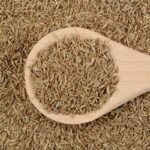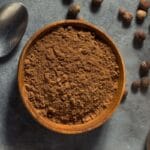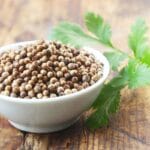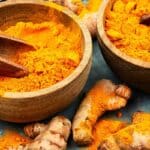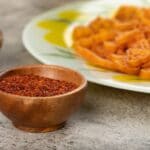Quick summary: For creating a curry powder substitute, you can combine some of the spices like cumin, turmeric, allspice, chili powder, and coriander. You can also go for already-made blends such as garam masala, chaat masala, or others.
Although one would naturally assume that curry powder is used to make Indian curry, you may be surprised to discover that it is not. The complex blend contains certain Indian spices but it is a British creation.
In the 18th century, British traders in India (which was under British rule at the time) wanted to take the unique flavors of India back home to Britain.
Since Indian cooking and authentic curry intricately combine different spices according to the region, the method of replicating the flavors was simplified in a pre-mixed spice blend.
One could probably say that curry powder is used in a Western version of Indian-style cuisine, however, it is still very different from authentic Indian cooking.
Curry powder is delicious in recipes like curried carrot soup, egg dishes, sauces for chicken, fish, or meat, curried rice salad, and vegetable seasoning.
If your dish calls for curry powder and you’re all out, there are some easy ways to bring similar flavors to your meal with spices you already have in your spice rack.
In this guide, we’ll provide you with the best curry powder substitutes to bring the same bold aromatic flavors to your dinner.
What Is Curry Powder?
The blend of spices used in curry powder may differ slightly depending on the manufacturer and the country you live in.
In the USA, curry powder contains turmeric, coriander, cumin, black pepper, ground ginger, fenugreek, ground cinnamon, and cardamom, with or without other additions.
Other additions may include ground cloves, curry leaf, cayenne pepper, or chili powder. Due to the turmeric present in curry powder, the spice blend has a yellow color that tints whatever you add it to.
Regardless of the brand you buy, the spice mix will bring an earthy and warm aromatic depth to your dish without having to measure or stock a multitude of different spices.
Can I Use Curry Powder in Thai Curry?
Curry powder is not used in red, green, or yellow Thai curries, and neither in authentic Indian curry. In fact, if you add curry powder to any version of Thai curry you will entirely change the dish to something that doesn’t resemble the Asian dish at all.
They may all have the word ‘curry’ somewhere in the name but they are completely different. Authentic Indian curry makes use of masala spice blend and not curry powder (more on that below).
When making Thai curries, you can often use a Thai curry paste specifically, however the complex flavor blend will be poles apart.
Best Substitutes for Curry Powder
Homemade Curry Powder
The closest match for a store-bought blend is to make your own curry powder at home. Turmeric is essential to get the yellow color, however, it does not add much to the flavor.
If you have the following spices in your pantry, mix them together well and store the blend in an airtight container. You should be able to get away with missing one or two of the spices if you don’t have them all.
- 4 teaspoons Ground Turmeric
- 2 teaspoons each Cumin and Coriander
- 1 teaspoon each Ginger Powder and Dry Mustard
½ teaspoon each of the following spices:
- Cardamon
- White Pepper (powder)
- Nutmeg (or mace)
- Ground Clove
- Cinnamon
Add a pinch of salt and if you like your food spicy also add a dash of cayenne pepper.
If you are missing a few of the above spices in your pantry, one of the below alternatives may be a better option for you.
Turmeric and Cumin
If color is important in your recipe, then this blend will give you the rich yellow hue from turmeric and an earthy, slightly spicy flavor from ground cumin.
The blend is great with rice, and vegetable dishes, as well as adding to soups and stews.
Substitute Quantity: Use equal amounts of turmeric and cumin in your blend to make up the required quantity. For example, if your recipe requires one teaspoon, then use half a teaspoon each of turmeric and cumin.
You can add a little more of either spice (or both) if you feel your dish needs more color or bolder flavor.
Cumin and Allspice
This blend won’t give you the yellow color, but you will get the warmth and slight sweet notes you are after. Although not as complex, this is a good choice for chicken recipes, sauces, and soups.
Allspice is used in Jamaican curry, marinades, meat rubs, and meat dishes. Many people mistake it for being a spice blend, when actually it is a single spice.
Allspice berries are dried and ground into a powder with a flavor reminiscent of cloves, cinnamon, and nutmeg with a slight peppery note.
Substitute Quantity: Blend equal amounts of allspice and cumin. Use 1 ¼ teaspoons of this blend for every teaspoon called for in your recipe.
Allspice, Chili Powder, and Turmeric
This three-spice blend brings heat, depth, and color! It’s a well-rounded mix of spicy, sweet, and bitter flavors without any one profile being particularly overpowering.
If you don’t like spicy food, move on to an alternative that doesn’t contain chili.
Substitute Quantity: To replace one teaspoon, mix half a teaspoon each of chili powder and turmeric with a quarter teaspoon of allspice.
Chili Powder and Cumin
If you like heat, here’s another option with two simple spices you may already have in the kitchen. This blend has a strong savory flavor and is great with hearty, meaty dishes that can stand up to the spicy punch.
Substitute Quantity: Mix the chili and cumin in equal parts. Use this blend as a replacement measure for measure in your recipe.
Turmeric, Coriander, and Allspice
Coriander and cumin come from the same plant family. If you don’t have cumin for the above substitute options, grab coriander instead for something just as flavorful.
Ground and toasted coriander seeds have subtle citrus notes with a nutty warmth. The strong earthy taste is well balanced and complemented with the slight sweetness of allspice in this blend.
Substitute Quantity: If your recipe calls for one teaspoon, mix half a teaspoon each of coriander powder and turmeric powder with a quarter teaspoon of ground allspice.
Spice Blends That Can Replace Curry Powder
There are a range of Indian spice blends that contain some of the same spices you’ll be after in your dish.
The word ‘masala’ refers to a blend of elements. The below spice blends each bring a unique flavor profile, however, each one will add a rich aromatic complexity that will complement the ingredients you are using.
Garam Masala
Garam Masala is an authentic Indian blend used in various Indian dishes, especially Indian curries.
The ratio of spices in this blend may vary according to the region it is from, but you can be assured of a deep comforting spice mix that is aromatic rather than spicy.
The blend generally includes cumin, coriander, cinnamon, cardamom, cloves, bay leaf, fennel, and black peppercorn.
Substitute Quantity: Replace garam masala in equal quantities.
Chaat Masala
This spice blend includes cumin, coriander, and black pepper as well as other punchy flavors such as ginger, chili peppers, and asafoetida or onion powder.
It has a little zing with a lovely blend of sweet and salty nuances. It’s a good option for spicy sauces and vegetarian stews.
Substitute Quantity: If you like a little heat to your dish, replace chaat masala in equal measures. If not, err on the side of caution and start with ¾ of the amount your recipe calls for.
Sambhar Masala
This spice blend is very similar to curry powder although it misses turmeric’s yellow coloring and contains coconut which gives it a slight sweetness.
The south Indian spice also contains coriander, cumin, mustard, black pepper, red chili, fenugreek, and cinnamon. This strong mix of flavors is popularly used in lentil stews and curries.
When used as a substitute it is best paired with robust ingredients like red meat that can stand up to its punch and should be used in smaller quantities.
Substitute Quantity: Use only half the amount of Sambar powder your recipe calls for.
Tandoori Masala
Tandoori Masala is known for its use in the popular dish, Tandoori Chicken. While it contains many similar ingredients, it also includes additional spices which amp up its flavor power.
It has an orange-red color as opposed to yellow. Unlike many of the other spice blends, it includes garlic powder.
Substitute Quantity: Start with half the amount required in your recipe. Let the spices infuse for a few minutes before tasting to see if you want to add a little more. This may depend on the delicacy or strength of other flavors in your recipe.
Indian Five Spice (Panch Phoron)
Panch phoron is another traditional Indian spice blend made of cumin, fennel, nigella, celery seeds, and fenugreek. The blend can be bought as whole spices or ground spice powder.
If you have the whole spices, toast them lightly before grinding them in a spice grinder for the best flavor. The blend is earthy, complex, and aromatic with a subtle sweetness and goes well with roast vegetables, dahl, and curry dishes.
You can intensify the heat in your dish by adding a little cayenne pepper or red pepper flakes.
Substitute Quantity: Start with half the amount required in your recipe. Let the spices infuse for a few minutes before tasting to see if you want to add a little more. This may depend on the delicacy or strength of other ingredients in your recipe.
FAQ
Dry spices can last for years. They may not go off as such or make you ill, but they will lose their flavor potency and have a muted, dull taste the longer they stand in the pantry.
To fix a curry that tastes too sour you can add some sweetness such as honey, caramelized onions, or even sugar. You could also dilute the dish, add some cream, or as a last option, add a pinch of baking soda.
If you have both, use a little of each in your dish. Although not authentic, crème fraîche will also give you a very similar flavor.
Yellow curry powder is used to bring great flavor and color to soups, stews, meat, sauces, vegetables, and marinades. It can even be added to egg dishes, potato salads, and hamburgers.
Although it’s not a traditional Indian spice mix, it contains some spices that are often used in Indian cuisine. This means you can easily use common Indian spices and spice blends if you are out of curry powder.
Remember that authentic spice mixes have a pungent aroma and intense flavors so use them in smaller quantities.
The wonderful thing about combining your own spice mixtures is that you can tailor it to the way you like it. If you don’t like heat, simply leave out the chili. If you love spicy hot dishes, add an extra dash. Enjoy the taste adventure!
You might want to read ideas for turmeric substitute or alternatives for cumin.
*image by photodesign/depositphotos


